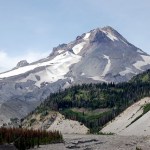Hood
"The secret of life is honesty and fair dealing. If you can fake that, you've got it made." -Groucho Marx
Now that the solstice is behind us and summer is officially here (for most of us), it's time to start enjoying the greatest fruits of the season. With the technical difficulties of the great scienceblogs migration (hopefully) behind us, I think I've discovered how to successfully bring a weekly song back to my weekend posts, too! Have a listen to Aimee Mann as she sings one of my favorites of hers,
Little Bombs.
Out where I live, in Oregon, now is the season that one of my favorite…
Mt. Hood in Oregon, taken August 2008. Image by Erik Klemetti. Click on the image to see a larger version.
Quick news!
I'm not going to go into too much depth right now about the recent study published in Nature Geoscience on Mt. Hood in Oregon - I plan to talk about it more in a few weeks. Why is that? Well, the lead investigator on the study, Dr. Adam Kent of Oregon State University, is a friend of mine (and occasional Eruptions commenter) so I plan to get the details from him before posting. I was also peripherally associated with some of this work - mostly in the field acting as a pack…
Some news for a sleepy Monday:
Mt. Hood in Oregon.
The ash from Eyjafjallajökull is, once again, causing significant airspace closure over northern Europe - close of 1,000 flights today. However, much of the closures are fairly short-lived, but that isn't keeping people happy. The eruption hasn't actually changed much, just that the winds are bringing ash towards Europe. The ash for the next few days will likely effect the England, Scotland, Ireland, Netherlands, France and possibly other parts of northern Europe (along with airspace over Greenland and the north Atlantic). The ash plume is…
Mt. Hood seen from Portland, Oregon. Image courtesy of the USGS/CVO.
I will be returning to my old haunts in Oregon (got my Ph.D. from Oregon State University - and yes, that is me in the upper left hand corner) for the next 6 days for the the Cascades, CVO and the multitude of igneous-rock-studying folks at Oregon State, Portland State, Univ. of Oregon, Univ. of Washington and so on, there is an awful lot to see. Two sessions I'm especially excited about are on supervolcanic/ignimbrite flareups and the Cascades volcanism and tectonics. A couple of these talks/posters I had some hand in, so…
Back in the days when Eruptions was on Wordpress, I held a vote about what volcano should be the next to be profiled on this blog. The winner was Mt. Hood in Oregon, and after much waiting, the profile is here. I will actually be out of town until Monday doing some house shopping in this little town. Enjoy this look at one of the most picturesque (and hazardous - #4 in fact) volcanoes in the lower 48 states.
VOLCANO PROFILE: MT. HOOD
Mt. Hood, Oregon in August 2008 taken by Erik Klemetti.
Location: Oregon, U.S.A.
Height: 3,426 m / 11,240 ft
Geophysical location: Along the Cascade arc where…
I am back from my trek through the Oregon and California Cascades - including stops at Lassen Peak/Chaos Crags, Hood, Three Sisters and Crater Lake (an added bonus). I'll try to catch up on the volcano news I've missed and post on anything exciting that happened soon, but otherwise I'll be posting new news as it occurs.
In the meantime, here's a picture I took of Rock Mesa (foreground) and South Sister (background) taken from the Pacific Crest Trail. Rock Mesa is a ~2,700 year old rhyolite flow that appears to have erupted multiple pumices and has some impressive flow banding of the rhyolite…
I will be away from Eruptions for the next 2 weeks or so. I won't be on vacation, I will actually be out on volcanoes themselves doing some much-needed fieldwork. It is a three volcano tour, starting with a trip to Lassen Peak to get a guided view with Michael Clynne of the USGS (the world expert on the volcano, the last Cascade volcano to erupt other than Saint Helens).
Then follows a trip to Mt. Hood with Adam Kent from Oregon State (my doctoral alma mater) in Oregon to sample some of the youngest flows that are only a few hundred years old. Geologists from Oregon DOGAMI (…

